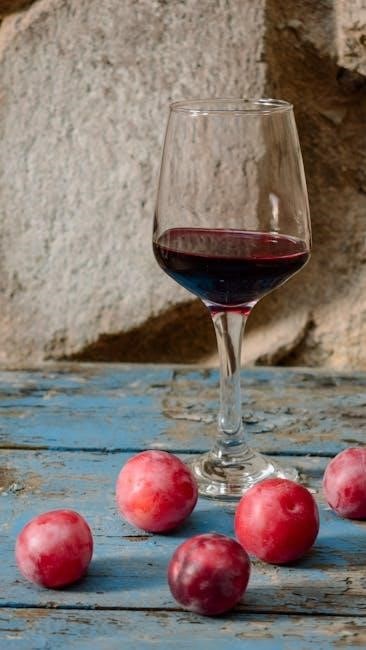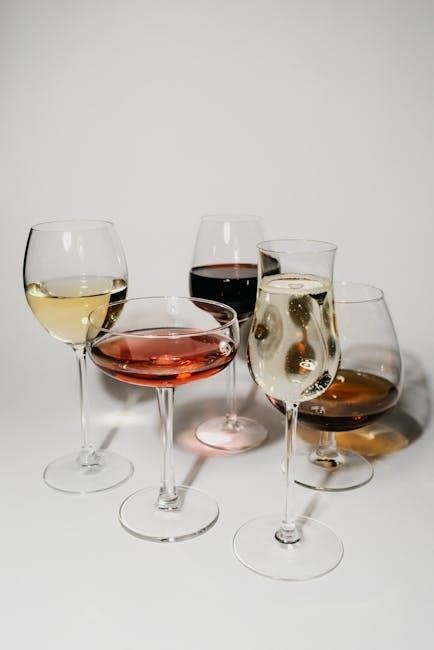Red wines have unique characteristics like acidity levels and flavor profiles, with power and complexity, making them a popular choice for wine enthusiasts, with many varieties to explore and discover daily.
Types of Red Wine
There are various types of red wine, each with unique characteristics like acidity levels and flavor profiles, with power and complexity, making them a popular choice for wine enthusiasts.
Red wines are known for their diversity, ranging from light and fruity to full-bodied and rich, with many styles to explore and discover.
Some red wines are blended with other varieties, while others are made from a single grape type, offering a wide range of flavors and aromas to appreciate and enjoy.
Understanding the different types of red wine can help wine lovers make informed choices and find their favorite styles, whether it’s a classic variety or a modern blend, with many options available.
From Merlot to Cabernet, and many others, the world of red wine is vast and exciting, with something to suit every taste and preference, making it a fascinating topic to explore and learn about.
Temperature and Serving
Red wines are best served at room temperature or a touch cooler, with most showing their best flavors between 60F and 65F.
Serving red wine at the ideal temperature helps avoid bitter flavors caused by chilling and enhances the overall experience.
Full-bodied reds may be served slightly warmer, while lighter reds can be served a bit cooler, allowing the unique characteristics of each wine to shine.
Allowing the wine to breathe, or decanting, can also soften tannins and release aromatic compounds, especially for younger, tannic wines.
Using a generously sized red wine glass can also enhance the experience, allowing the wine to aerate and the flavors to unfold, making every sip a pleasure.
By serving red wine at the right temperature and in the right glass, wine lovers can fully appreciate the complex flavors and aromas of their favorite red wines, every time.

Popular Red Wine Varieties
Many popular red wine varieties exist, offering diverse flavors and styles, with regions producing unique wines, and pairing tips available for exploration and discovery daily always.
Merlot and Cabernet
Merlot is often blended with Cabernet, with which it shares many characteristics, including flavors of plums, herbs, and mint, with Merlot typically being softer and plusher on the palate than Cabernet. The combination of these two varieties creates a well-balanced wine with a rich flavor profile. Merlot adds a fruity and approachable character to the wine, while Cabernet contributes structure and complexity. This blend is popular in many regions, including Bordeaux, where it is a classic combination. The result is a wine that is both elegant and full-bodied, making it a great choice for a variety of occasions. With its smooth tannins and flavors of dark fruit, the Merlot and Cabernet blend is a popular choice among wine enthusiasts, and its versatility makes it a great pairing for many different types of cuisine. Overall, the Merlot and Cabernet blend is a great example of how different varieties can come together to create something unique and delicious.
Cabernet Sauvignon
Cabernet Sauvignon is a red wine grape variety that is widely cultivated and enjoyed, known for its full-bodied flavor and high tannin levels. It is a popular choice among wine enthusiasts, with a rich flavor profile that includes notes of dark fruit, spice, and earthy undertones. The flavor profile of Cabernet Sauvignon is influenced by the region in which it is grown, with New World wines tend to be fruit-forward and Old World wines tend to be more earthy and subtle. Cabernet Sauvignon is often aged in oak barrels, which adds complexity and depth to the wine. The aging process can last from several months to several years, depending on the desired level of complexity and maturity. Overall, Cabernet Sauvignon is a versatile and flavorful wine that pairs well with a variety of foods, including red meat, game, and robust cheeses, making it a great choice for special occasions.

Production of Red Wine

Red wine production involves fermenting dark-skinned grapes with skins and seeds, creating unique flavors and colors, using traditional methods and techniques daily always.
Fermentation Process
The fermentation process is a crucial step in producing red wine, involving the conversion of grape sugars into alcohol by yeast. This process typically includes the grape skins, seeds, and sometimes stems, which lend the wine its characteristic color and contribute to the flavor profile. The fermentation process can last from several days to several weeks, depending on the winemaker’s goals and the specific grape variety being used. The resulting wine is then pressed, separating the liquid from the solids, and transferred to oak barrels or stainless steel tanks for aging and further development. The fermentation process requires careful monitoring and control to ensure the production of high-quality red wine. The winemaker’s skill and experience play a significant role in determining the final product’s flavor, aroma, and overall character, making each bottle unique and distinct. Proper fermentation is essential for creating a rich and complex red wine.
Color and Flavor Profile
The color of red wine can range from a light ruby hue to a deep, opaque purple, depending on the grape variety and winemaking process. The flavor profile of red wine is equally diverse, with notes of fruits, spices, and earthy tones. The color and flavor profile are influenced by factors such as the grape skin, seeds, and stems, as well as the aging process. Oak barrels, for example, can impart vanilla and caramel flavors to the wine. The color and flavor profile of red wine can also be affected by the region and climate in which the grapes are grown. A wine’s color and flavor profile can provide clues to its origin and quality, making it a fascinating aspect of red wine appreciation. The complexity of red wine’s color and flavor profile is what makes it so appealing to wine enthusiasts and collectors. Wine lovers appreciate the unique characteristics.

Specific Red Wine Grapes
Red wine grapes vary greatly in terms of flavor and quality, with distinct characteristics shaping wines daily always.
Pinot Noir
Pinot Noir is one of the noblest red wine grapes, known for its difficulty in growth and rare blending, resulting in a smooth and refined flavor profile.
The flavor profile of Pinot Noir is often described as earthy and fruity, with hints of berries and spices, making it a popular choice for wine enthusiasts.
It is typically paired with grilled salmon, chicken, lamb, and Japanese dishes, and its delicate flavor makes it an excellent choice for those looking for a lighter red wine.
The production of Pinot Noir is often limited, making it a sought-after variety among wine collectors and connoisseurs.
Overall, Pinot Noir is a unique and complex red wine grape that offers a distinct and refined drinking experience, with its flavor profile and pairing possibilities making it a popular choice among wine enthusiasts.
Its noble status is well-deserved, and its popularity continues to grow among wine drinkers.
Decanting and Glassware
Decanting is a process that allows red wine to breathe, softening tannins and releasing aromatic compounds, especially for younger, tannic wines.
This process can enhance the overall flavor and aroma of the wine, making it a popular practice among wine enthusiasts.
The use of proper glassware is also essential, as it can affect the way the wine is perceived, with a generously sized red wine glass allowing for proper aeration and appreciation of the wine’s color and aroma.
The shape and size of the glass can influence the way the wine is experienced, with different glasses suited to different types of red wine.
By using the right glassware and decanting the wine, drinkers can fully appreciate the complexities and nuances of red wine, and enjoy a more satisfying drinking experience.
Proper decanting and glassware can make a significant difference in the enjoyment of red wine.



